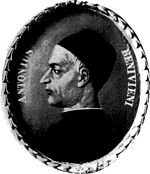Antonio Benivieni facts for kids
Quick facts for kids
Antonio di Paolo Benivieni
|
|
|---|---|

Antonio di Paolo Benivieni (1443‐1502)
|
|
| Born | November 3, 1443 |
| Died | 1502 Florence, Italy
|
| Nationality | Italian |
| Known for | autopsy, pathology |
| Scientific career | |
| Fields | medicine |
Antonio di Paolo Benivieni (1443–1502) was an important physician from Florence, Italy. He was one of the first to use autopsy to understand diseases. Many medical historians see him as a founder of pathology, which is the study of diseases and their causes.
Contents
Biography
Early Life and Education
Antonio Benivieni was born in Florence, Italy, on November 3, 1443. His father, Paolo, was a nobleman and notary. His family was well-known and wealthy in Florence.
Antonio first studied literature, including Greek. Later, he decided to focus on philosophy and medicine. He continued to have the support of the powerful House of Medici, including Cosimo il Vecchio and Piero il Gottoso. Benivieni studied medicine at the universities of Pisa and Siena.
Doctor and Friend of the Powerful
Benivieni started working as a doctor around 1470. He quickly became very famous in Florence. People trusted his diagnoses, his use of medicines, and his skills as a surgeon.
He treated members of very important families, such as the Medici, the Pazzi, and the Strozzi family. He also worked as a doctor for several convents. He was a friend and doctor to Gerolamo Savonarola, a famous religious leader. Benivieni was also close to Lorenzo il Magnifico, a powerful ruler of Florence, and treated Lorenzo's daughter.
Antonio Benivieni owned many books in Greek, Latin, and Arabic. This collection showed his wide knowledge, not just in medicine but also in humanistic studies.
Death
Antonio Benivieni died in Florence on November 2, 1502. He was buried in a chapel in the Basilica of SS. Annunziata.
Contributions to Medicine
Understanding Disease in the Renaissance
During the Renaissance (from the 14th to the 17th century), people became very curious about how the human body worked and what caused diseases. The first autopsy done to find the cause of death happened in 1302 in Bologna.
By the late 1400s, the Church and governments allowed doctors to perform dissections more freely. This meant that autopsies, which help understand why someone died, became more common. They were done in hospitals and even in private homes.
De Abditis Morborum Causis
Antonio Benivieni was known as a very skilled diagnostician. His most important work is called "Abditis morborum causis" (The Hidden Causes of Diseases), published in Florence in 1507. This book contains some of the first objective studies of how diseases affect the body's structures.
In this work, Benivieni showed that doctors needed to connect what they saw in patients (the symptoms) with what they found during autopsies. This idea was very important for understanding diseases correctly. Two centuries later, Giovanni Battista Morgagni was inspired by Benivieni's work. Morgagni's book, published in 1761, truly started the field of pathological anatomy.
Benivieni's book describes many important findings. These include the discovery of gallbladder stones, a peritoneal abscess (a pocket of infection in the belly), and gastrointestinal cancer (cancer of the stomach and intestines). He also described the first intestinal perforation (a hole in the intestine) in medical history. He was also the first to study teratology (the study of birth defects) in an objective way. His studies on helminthology (the study of parasitic worms) were also very important.
How the Book Was Published
Antonio Benivieni did not publish his medical writings during his lifetime. After he died, his brother Girolamo found some of his notes. These notes described many interesting medical cases. Girolamo sent them to Giovanni Rosati, another important physician. Rosati thought they were brilliant and suggested publishing them. So, a part of these writings was published in 1507.
The original manuscript of Benivieni's work was lost for a time. It was later found and published again in the 19th century. Today, the original manuscript is lost again.
Benivieni's Discoveries
De Abditis Morborum Causis is considered one of the first books in the science of pathology. This is why Benivieni is often called the "father of pathologic anatomy."
The book contains about 111 observations. These show Benivieni's great skills in medicine, surgery, and obstetrics (care during childbirth). Some notable observations include:
- Liver stones in a woman.
- A bone resection (removing part of a bone) he performed on a young girl.
- Extracting a dead fetus with a hook.
- Observations on lithotripsy (a procedure to break up stones in the body).
- Many observations on birth defects (teratology).
He also described other interesting findings from autopsies:
- An abscess (a collection of pus) in a young woman's abdomen.
- Narrowing and hardening of the intestine, possibly a cancer, in a woman with severe stomach pain and constipation.
- A cancer of the pylorus (the opening from the stomach to the small intestine) in a man with constant vomiting.
- Holes in the intestines from chronic dysentery (a severe infection).
- A megacolon (a very enlarged colon) in a child who died of stomach pain.
- A heart that looked "bristly" or "hairy" in an executed man.
Why Benivieni's Work Is Important
Benivieni's work is very important because he was one of the first to connect what he saw in patients during their lives with what he found during autopsies after they died. He tried to find the exact causes of death. He also worked to link symptoms people had while alive with the changes found in their bodies after death.
This method of connecting clinical observations with anatomical findings, started by Benivieni, slowly grew over the centuries. It reached its peak with Giovanni Battista Morgagni. Benivieni's work also shows how important autopsies were considered even in his time.
See also
 In Spanish: Antonio Benivieni para niños
In Spanish: Antonio Benivieni para niños


